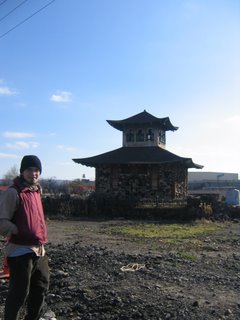
One of the things that I love about this state is its sense of fading glory. You see, with fading glory, you don’t get any of the arrogance of new growth, or the growing pains. Don’t get me wrong, being a crumbling Rust Belt town comes with its own sorrows and pains, but it also seems to come with grim determination and stately resolve. And after all, who’s seen a building built in the last ten years that wasn’t as ugly as sin?
In our forests you find the remnants of old stone walls and farmer’s wells and in the brownfields and old neighborhoods of our cities are hidden little gems.
This last weekend, Natalie came up for a visit to my hometown of Johnson City and we took a tour of the crumbling industrial center of what used to be a company town. We stopped by all of the sites: the chrome 1950s diner, the beautiful wooden Ukrainian Orthodox Church, what used to be the world’s largest shoe factory and the nifty little county nature center where the staff does wonders with a shoestring budget and a couple dozen stuffed animals they got from the State Troopers cleanup of roadside accidents.
For me, though, the real highlight was a little building in the middle of a brownfield. Literally surrounded by the rubble of much grander factories survives the Pagoda. It kind of reminds me of the Once-ler’s house in The Lorax, you remember that strange little run-down building boxed in by leaning walls and overgrown grass?

The Pagoda was once the Pump House, some people say for the cooling machinery in the neighboring factory, others claim it pumped water for the nearby swimming pool constructed for workers and their families. Regardless, the Pagoda was built around 1925 by employees of the EJ Shoe company largely using garbage. The walls are made of broken bits of brick and pieces of metal. Broken gears, old knives and chains, bells and even a fire extinguisher were all incorporated into the walls of the Pagoda. I personally see it as a monument to the ingenuity and creativity of the EJ workers who constructed it. It has survived the destruction of all its neighbors simply because it is so charming and bizarre that even the normally inept and blind village government got its act together and protected it. I’ve even heard that there is a grant in the works to transport it across the street to CFJ Park (where the old pool was located) where it would be theoretically protected forever. The photos here are of me at the Pagoda, notice the gears and other things stuck into the walls.
And for those of you who haven’t read the Lorax lately do you remember:
“At the far end of town/
where the Grickle-grass grows/
and the wind smells slow-and-sour when it blows/
and no birds ever sing excepting old crows.../
is the Street of the Lifted Lorax/”
Posted by Jesse

3 comments:
Enjoyed this a lot, and I'm looking forward to reading your blog further. I'm originally from Vestal and your take on the faded glory aspect of the Southern Tier is right on. Nice job!
Cuz, are you sure it was actually constructed by EJ workers? I can't recall if it was or not but think it's worthwhile to look into, the historian at Home Public Biblioteca would know.
while i don't know any further history on the subject, i've got a couple of pictures i shot of the same pagoda in the beginning of april 2007 here and here
the greater binghamton area has a tremendous amount of interesting history and architecture.
Post a Comment